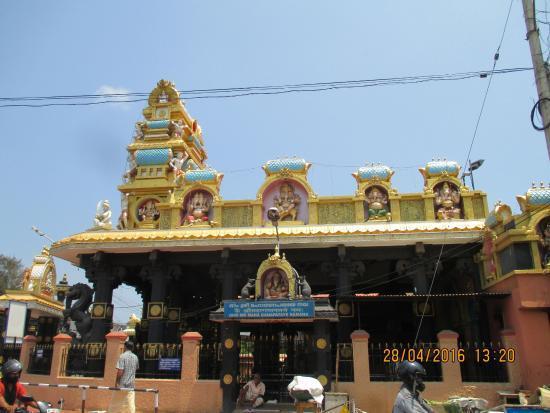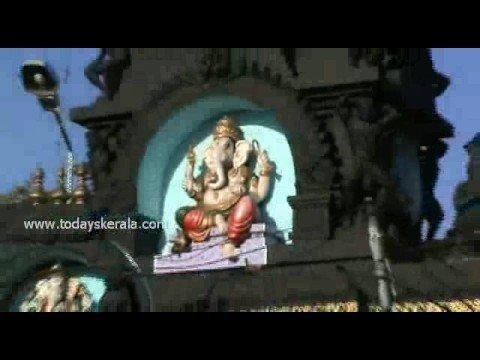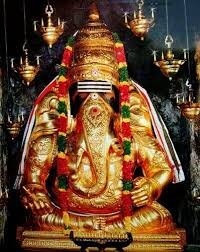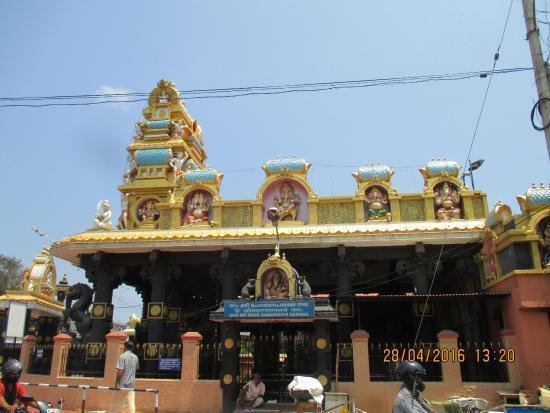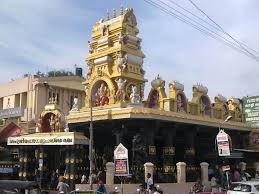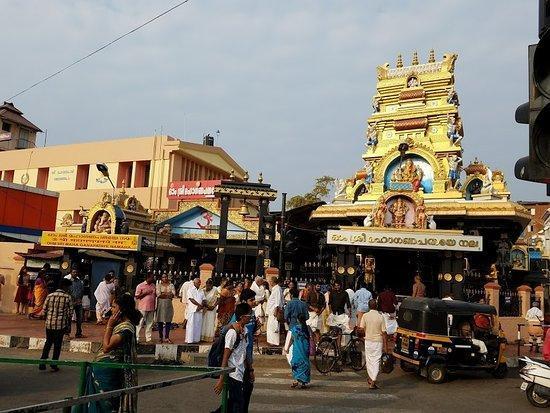Pazhavangadi Ganapathy Temple, Thiruvananthapuram, Kerala
| Date built: | – |
|---|---|
| Deity: | – |
| Architectural style: | – |
| Major festivals | Thiruvonam, Vijayadashami, Vishu, Vinayaka Chathurthi |
| Locale: | Thiruvananthapuram |
| District:: | Thiruvananthapuram |
| Address: | Padmavilasam Rd, Pazhavangadi, Padma Nagar, Pazhavangadi, Thiruvananthapuram, Kerala 695023 |
| Phone | 04712461929 |
The Pazhavangadi Maha Ganapathy temple(Malayalam: ശ്രീ പഴവങ്ങാടി മഹാ ഗണപതി ക്ഷേത്രം) is situated at East Fort in the heart of Thiruvananthapuram City. The main Deity of the temple is Sri Mahaganapathy (Ganesha). The main idol is installed in a seated posture with the right leg in a folded stance. The temple is situated in close proximity to the Sri Padmanabhaswamy temple. Other Deities worshiped at the temple include Dharmasasta, Goddess Durga and Nagaraja. The temple sculptures include 32 different forms of Lord Ganesha.
Architecture
Legend / Local stories
The history of temples at Thiruvananthapuram owned by the Madras Regiment and managed by the Madras Regimental Centre is associated with the history of Venad (later Travancore) and its army. The earliest recorded reference on Venad is found in the Madras Museum plates of Parantaka Neduncatain whose period has been ascribed to 765 and 815 A.D. In this period, the royal family of Venad resided at different places resulting in establishing five branches (taavazhis) viz., Venad, Tiruvitaamkod, Trippaappoor, Chiravaayi and Desingnad. Of these, the first three branches assumed responsibilities of ruling the principality. Venad ruler, who also used the title of Chiravaayi Mooppan, was the sovereign authority. Trippappoor (or Keezhperur) Mooppan was considered as the heir-apparent with distinct responsibility to administer the Sree Padmanaabhaswaamy temple in particular and other temples in the principality in general. At that time the jurisdiction of Venad extended over a small tract lying between Thiruvananthapuram and Kollam (Quilon). It, however, got independent status in the beginning of the twelfth century, after the decline of power of the Kulasekhara Empire in Kerala. By the end of thirteenth century, Venad flourished with Kollam (Quilon) as its capital. Towards the beginning of the fifteenth century, the capital of Venad was shifted from Kollam to Tiruvitaamkod (now in Kanyakumari district of Tamil Nadu). The rulers of Venad continued to have their seat at Tiruvitaamkod till Darapakulangara palace was built at Kalkkulam. The political scene of Venad underwent remarkable changes when Anizham Tirunal Veera Bala Marthaanda Varma assumed as Trippaappoor Mooppan and later when he ascended the throne of Venad in 1729 A.D. (904 M.E.) at the age of 24, following the demise of his uncle Veera Rama Varma. His first major step was suppression of his hostile feudal elements and he carried out the annexation of several principalities on the north of Venad viz. Attingal estate, Desingnad, Elayadatth swaroopam, Kayamkulam, Ambalapuzha, Tekkumkoor, Vatakkumkoor besides small territories belonged to nobles. He thus became the first local Raja whose jurisdiction extended from Kanyakumari in the south to Arookutti in the north. Further he was responsible for the establishment of a centralized administration. Maarthaanda Varma (1729-58 A.D.) rebuilt the Kalkkulam palace in 1744 A.D. and shifted his capital from Tiruvitaamkod to the new place and renamed Kalkkulam as Padmanaabhapuram. From the time of Maarthaanda Varma the unified state is known as Tiruvitaamkoor (or Travancore in later records). After the unification of the state he took a momentous step of Trippati Daaanam (dedication of the kingdom) to his tutelary deity Sree Padmanabhaswaamy of Thiruvananthapuram on 5th Makaram 925 M.E. corresponding to 03 Jan 1750 A.D. Thereafter he and his successors ruled Travancore as Padmanaabha-daasas or servants of Sree Padmanabhaswaamy. By the Trippati Daanam concept the State belonged to the Lord and it helped in the long run to pave political stability in the State.
Consequent to the establishment of a centralized military monarchy, Maarthaanda Varma took initiative to strengthen his armed forces, as by this time Travancore became a great political power to be reckoned with in southwest of India. In 1757, the Travancore Army consisted of 30,000 Nairs (10,000 regular and 20,000 irregular infantry). Due to renewed insurrection within the army in 1809, the whole military force of Travancore was disbanded with the exception of the First Nair Battalion and few mounted troops who were retained for purposes of State and ceremony. A Second Battalion of Nair troops raised the strength of the army during the reign of Raani Gouri Paarvathi Baayi (1815-29) besides forming a new detachment of artillery. Though the Nair battalion continued from 1809 A.D. the designation of the army was changed as Nair Brigade only in 1830 A.D. In 1836 all British troops in Travancore with an exception of one regiment, which was left at Kollam, were withdrawn and the Nair Brigade took over the barracks at the Cantonment (Thiruvananthapuram) occupied previously by the British. They continued there till 1935 when the Nair Brigade was renamed as State Forces and their Station Headquarters shifted to the present site at Pangode. In 1951 the State Forces were integrated with the Indian Army and these forces later formed part of the Madras Regiment. All the officers and jawans who gloriously served the State Forces till 1956 were closely associated with the temples managed by them at Pazhavangadi and at Pangode.
The origin of Sree Maha Ganapathy temple at Pazhavangadi is connected with Padmanabhapuram, the erstwhile capital of Venad. The legend says that being the capital and seat of the Raja, the soldiers had to guard the Padmanabhapuram Palace and the Fort on all sides by sentries. On one of its side is the famous shrine of Yakshi (fierce Spirit Goddess) at Melaankot. Because of the greater fierceness of Yakshi no soldiers dared to take up duty at this point. Whoever had taken night duty was seen lying unconscious on the ground the next day morning. This continued for a long time. On one occasion, the duty of guarding Melaankot fell on to a devotee of Lord Ganapathy. While he was taking bath on the duty-day in the close-by Valliyoor River, his leg touched a stone lying in the river-bed. When he took the same out of the river-bed, he found it to be a very small idol of “Lord Ganapathy”, of about six inches. Feeling the divine grace, he decided to take the idol in his pouch at the time of his duty. As usual Yakshi tried to harm him but Lord Ganapathy guarded him from her blows. Seeing the soldier return harmless the next-day morning other soldiers were very curious and enquired about the reason for his safety. Initially he was reluctant to reveal the reason but on persuasion he divulged the possession of the idol and its immaculate powers. As the idol was shown to the sentry by the Lord Himself, other soldiers in the barracks of Padmanabhapuram took initiative (around 1750 A.D.) to worship the same within the barracks before commencing their official daily-routines. From that day onwards “Lord Ganapathy” became a war-God of the Nair Brigade. As the idol was obtained by the will and blessings of the Lord from a river-bed, the idol is considered as self-revealed, one of Lord (swayambhoo) and soldiers were bestowed with the responsibility of preserving the idol at all cost without causing any damage to it for ever. They continued to worship this idol at Padmanabhapuram till it was shifted to Thiruvanathapuram, during the reign (1758-1798 A.D.) of Sree Kaarttika Tirunal Maharaja, popularly known as Dharma Raja. In this context, it has to be mentioned that Sree Padmanabhaswaamy temple possesses, perhaps, the largest and most fabulous hoard of palmyrah-leaf records ever discovered in Kerala, dating back to 550 Malayalam (Kollam) era (1375 A.D.). These records are popularly known as Mathilakam records and is written in ola (palmyrah leafs) and kept in churunas (scrolls). In churuna 11 ola 150 it has been stated in one of such records that silver throne of Maharajah was brought from Padmanabhapuram for his use in 935 ME/1760 A.D, which indicates the year of shifting of capital to Thiruvananthapuram in 1760 A.D. In another such record (Volume 13, Churuna 1282 of 946 M. E / 1771 A.D.) it has been stated that “to be free from the obstacle of rain during the ezhunellatt (procession of Maharaja) towards east 300 coconuts have been broken at the Pazhavangadi Ganapati temple.” This record throws light that the temple was in existence at Pazhavangati earlier than 1771 A.D.
When the capital of Travancore was shifted in 1760 A.D. from Padmanabhapuram to Thiruvananthapuram, major portion of the army was also moved to Thiruvananthapuram. The idol of Lord Ganapathy was also taken to Thiruvananthapuram and for sometime kept under a peepul tree of Sree Pazhaya Sreekanteswaram temple. Then with the generous help of Dharma Raja a small shrine was built in the Magazine Area, located in the Fort Area (present Pazhavangadi) around 1765 A.D. Renovations were carried out in later years particularly during the period of Aayilyam Thirunaal Raama Varma Maharaja (1860-80). Subsequently two minor deities were installed viz, Goddess Durga Bhagavati (symbolizing sarva-sakti-swaroopani or as an embodiment of all energies) and Lord Vettakkorumakan (younger son of Lord Siva in Goddess Paarvati and is considered as war-God with churika (dagger) in hand). Thus all deities in this temple are ideal and best suited for welfare of soldiers and success in warfare. The exact dates of installation of these idols are not known. A Bhajana-mandapam was opened on September 9, 1983. Laying the foundation stone of the imposing Mandapam with gopuram on the eastern side of the temple was done on 31st December 1993 and it was declared open on March 25, 1996. Major renovations were also carried out in 1996. A Reference Library with rare collections of religious books in Sanskrit, English and other languages was formally opened at the top floor of the Bhajana-mandapam on March 9, 2003 The work of providing Lift service to the Library for the use of public, especially for the use of senior citizens started on June 23, 2006 but it became fully operative only in April 2009. Three sides of sub-shrines of Lord Vettakkorumakan and Goddess Durga Bhagavati were covered with decorated brass sheets for safety and for ambience in August 2009.
Photo Gallery
How to Reach:
The temple is located 0.5 km from the Thiruvananthapuram Central railway station and the central bus station. The nearest city bus stand is at East Fort.
Thiruvananthapuram International Airport is about 8 kilometers away from the temple.
Contact Details
Official Address

